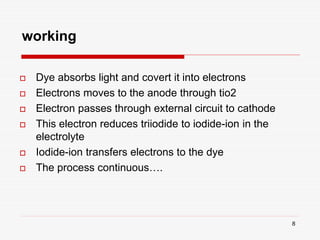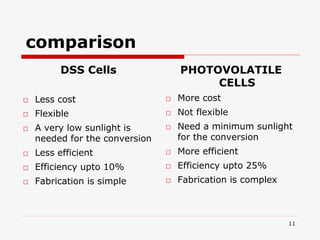Dye sensitised solar cells
- 2. 2 Preview Introduction Paths to modern era Construction Working Advantage and disadvantages Comparison Conclusions
- 3. 3 Introduction □A solar cell is a device which converts light energy to electrical energy. □It is not ecofriendly and economic.
- 4. 4 Introduction (Contd…) □Dss cells are made with organic dyes □Converts light energy to electric energy □Eco-friendly and economic
- 5. 5 Invented in 1988 by Michael Grätzel and Brian O'Regan Michael Grätzel has been awarded the 2010 Millennium Technology prize for this invention in the beginning the efficiency was up to 9% At present efficiency improved to 11% Mncs aiming to launch commercial products in future The research is going on……. Paths to modern era
- 6. construction 6 □Electrolyte in between anode and cathode □Tio2 and dies □External circuit
- 8. 8 working Dye absorbs light and covert it into electrons Electrons moves to the anode through tio2 Electron passes through external circuit to cathode This electron reduces triiodide to iodide-ion in the electrolyte Iodide-ion transfers electrons to the dye The process continuous….
- 9. 9
- 10. Advantages and Disadvantages Advantages □ Ability to Work at Wider Angles and in Low Light □ Long Life □ Good Price/Performance Ratio □ Low Cost □ Mechanical Robustness □ Ability to Operate at Lower Internal Temperatures □ Lowering the electricity bills Disadvantages □ DSSC design is the use of the liquid electrolyte □ which has temperature stability problems □ costly ruthenium (dye), platinum(catalyst) □ the electrolyte solution contains volatile organic compounds (or VOC's), 10
- 11. comparison DSS Cells □ Less cost □ Flexible □ A very low sunlight is needed for the conversion □ Less efficient □ Efficiency upto 10% □ Fabrication is simple PHOTOVOLATILE CELLS □ More cost □ Not flexible □ Need a minimum sunlight for the conversion □ More efficient □ Efficiency upto 25% □ Fabrication is complex 11
- 12. Conclusion □ Good for environment □ Development of this technology is essential □ Large investments leads to a solution for country’s energy crisis □ Need of Governments direct involvement to generalise this idea □ Large change in economy. 12
- 13. Refrences □ Google □ Wikipedia □ Science direct 13
- 14. THANK YOU 14













